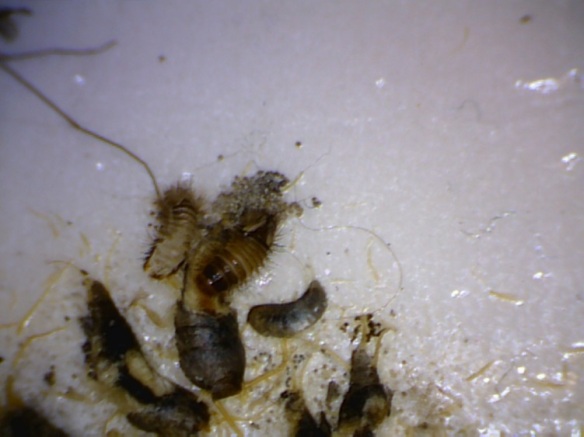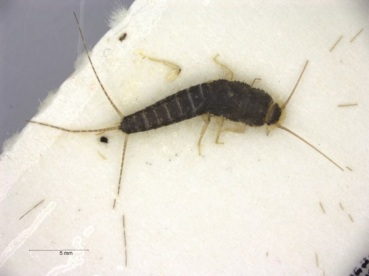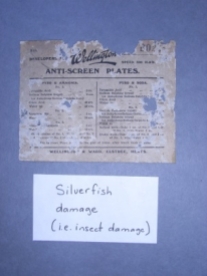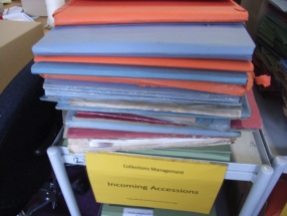- Want to avoid uninvited guests eating your collection!?
- Keen to make sure the surrounding environment is safe for archives?
Let me introduce you to our silverfish, a Grey Silverfish (ctenolepisma longicaudata). They are fairly new to the UK, and this is the first one we have found. We will be keeping the traps out and our eyes peeled just in case he has brought friends and relatives! They are more tolerant of dry conditions than regular silverfish.
Insects get everywhere so it is best to expect them and keep an eye out ! You can get sticky traps that will catch them and give you an idea of what’s about. There’s no need to worry unless you suddenly find a lot more insects than usual! If this happens you might need to take a closer look, and find out where they are coming from.
When you add new things into your collection it’s worth checking them over first. You don’t want to introduce anything that is going to come back to bite!
Pests can be very small . . .
. . . and good at hiding!
If they have moved in, it’s important to remove any items that show signs and isolate them. Putting something in a plastic bag and sticking it in the freezer for 3 or 4 weeks should kill most things off! Be sure to allow the bag to come to room temperature again before you remove the item though – you don’t want condensation on it (like when you take the ice-cream tub out of the freezer!).
Make sure there’s nothing else around that might be attracting pests – or vermin-, like bits of food, ingredients in storage (flour attracts a number of different bugs), or in the bin. Don’t forget pet food and dead insects in traps – it’s good to check them regularly!

This picture shows ‘Woolly Bears’ (larvae of the carpet beetle) eating a silverfish carcass.
Pests also come rodent sized! Something had a good meal out of this parchment manuscript long before the archives took it in (the manuscript, not the rodent!)

A clean environment
A regular dust and hoover of the room, shelves and other furniture is a good habit to adopt. Dust can provide nutrition for insects, think skin flakes and oils, and brings its own hazards. It can be abrasive, acting like sandpaper and putting tiny scratches in things. If you are on the look out for pests as you clean you will complete a ‘pest inspection’ and have a satisfyingly dust-free and clean space when you finish. The beneficial exercise is of course another bonus!!
It’s best not to use cleaning products and polishes, and to keep to dry methods as chemicals and residues may affect some materials over time. We call them pollutants, and worry about the effects they might have too! (Paints may also contain harmful solvents, so it’s worth checking what is suitable when you want to decorate.) (See our Blog CC #4 on preventing damage.)
Cool and dry conditions
It’s best to avoid pests taking up residence in the first place. If there is some regular air flow, and you keep the area cool and dry, they are less likely to want to stay. Good air-flow helps to avoid dank corners and pockets of stagnant air.
It’s worth getting a temperature and humidity monitor so you can see what happens through the changing seasons – it can be surprising how warm or humid it can become without you knowing! You could check it regularly and keep a record so you can see if things start to change. Our Caring for Collections Action Checklist (see Blog CC #3) will help you cover the basics.
For archive collections an average temperature of 18 degrees centigrade is recommended over the course of a year, keeping it above 13 degrees (to avoid condensation problems), but no higher than 23 degrees, with humidity levels between 35 and 60%. A day or two outside of these ranges shouldn’t be a problem, but continuing high levels of heat and/or humidity will cause things to stew in their own juices! Think of an oven left on low, gently slow-cooking your stuff! Chemical reactions happen faster, so decay rates for organic materials (what all of our archives are made of) speed up, and we want to avoid that if possible!
There is also a chance – if humidity levels rise too much, or temperatures drop while humidity levels don’t, or if there are colder zones alongside outside walls in your store where condensation can develop, that you could end up with a mould outbreak – not good for collections, your health or your stress levels!
It’s best to avoid storing your collection in a basement, attic, garage or garden shed. Unless it has been specially converted, it is unlikely to be cool and dry all year round.
Watching light levels
Insects don’t like to be disturbed, and prefer dark, dank places with a supply of food close by.
Don’t be tempted to flood the place with light though, particularly if you have anything on display, or stored in the open on shelves (like books) because the light can also introduce heat (especially if through a window), and fade colours. Light is high in energy (think solar panels ) and can cause damage at the molecular level, which can lead to changes in appearance, and material weakness.
So check out the links below for more info, and keep those critters out!
- Pest Control News – Grey Silverfish: https://www.pestcontrolnews.com/the-grey-silverfish-paperfish-found-in-the-uk/
- British Pest Control Association – information about woolly bears
- Identification website: http://www.whatseatingyourcollection.com/
- Norfolk archives have some useful tips: https://www.archives.norfolk.gov.uk/community-archives/preservation/storage-area
- For more on monitoring and managing the environment have a look at this useful guide from the British Library
Based on Gloucestershire Archives Heritage Hub Collection Care training developed by Ann Attwood ACR Collections Care Development Officer and Rachel Wales ACR Collections Care Conservator
At Gloucestershire Archives, through our National Lottery Heritage funded “For The Record” project, we will support people to: “document, care for, interpret and celebrate their personal and shared history”.












Pingback: How to preserve your family or community archive: the Collection Care Covid-19 lockdown blogs. Blog CC #14 | Gloucestershire Archives
Pingback: How to preserve your family or community archive: the Collection Care Covid-19 lockdown blogs. Blog CC #15 | Gloucestershire Archives
Pingback: How to preserve your family or community archive: the Collection Care Covid-19 lockdown blogs. Blog CC #17 | Gloucestershire Archives
Pingback: How to preserve your family or community archive: the Collection Care Covid-19 lockdown blogs. Blog CC #18 | Gloucestershire Archives